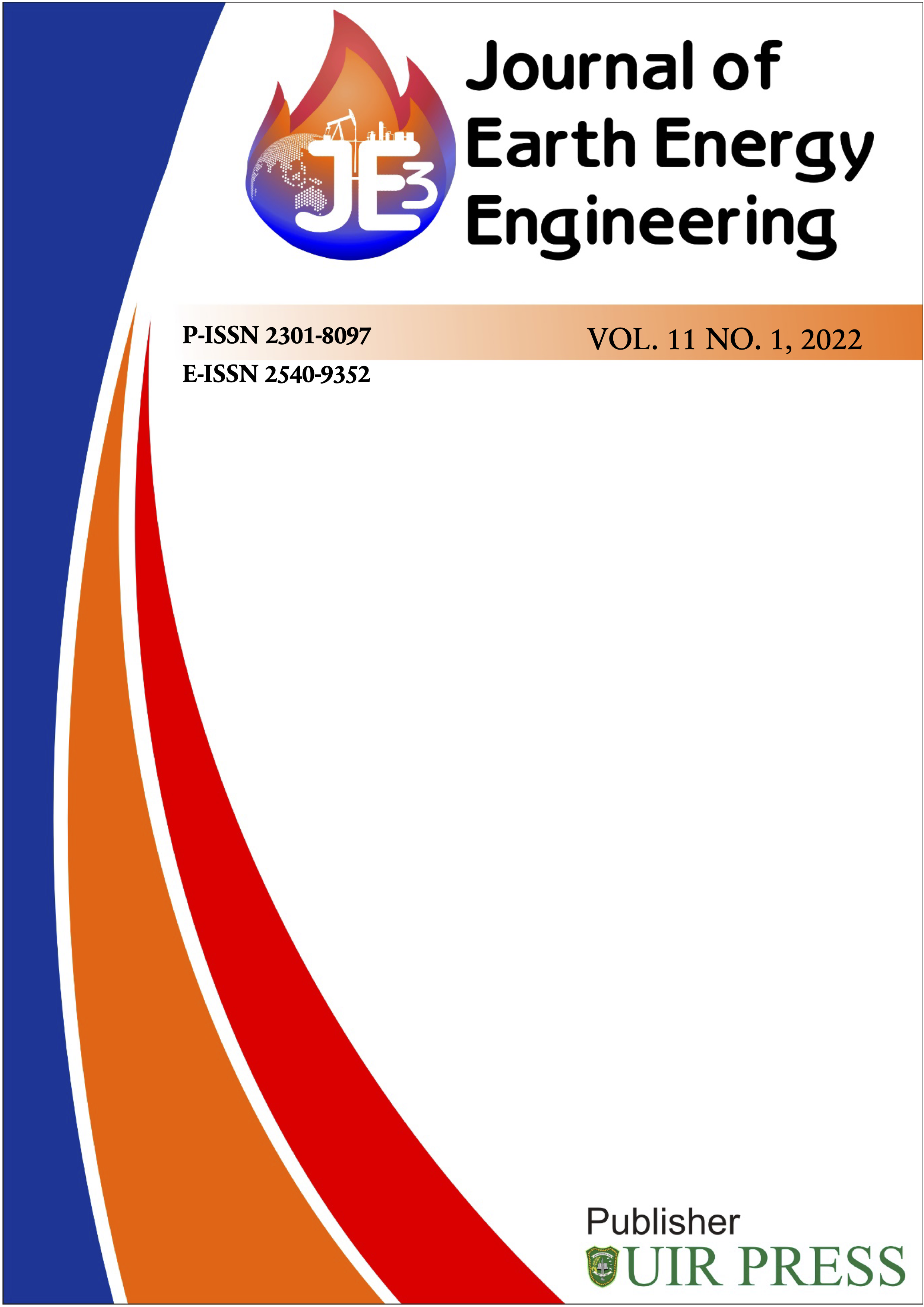Evaluation of Remaining Gas Reserves Using the Material Balance Method for Planning Gas Field Development
Abstract
The demand of energy in the world will increase due to the increasing population and industrial activity. Currently, the fossil energy is relatively cheaper compared to other energy sources, especially natural gas. The “CJ” field is a gas field located in the South Sumatra Basin, Indonesia with a reservoir located in the Basalt Telisa Limestone (BTL) formation. This gas field consists of 3 wells namely Well GTA-1, GTA-2, and GTA-3 which produced from 1951 to 1991. In 1991 the three wells were suspended and will be reopened in 2021 due to request from buyers for 10 years. The research method is collecting and consisting of data on reservoir, production, and physical properties of the gas. The next step is to calculate the value of the gas formation volume factor and Z-factor (gas compressibility factor/gas deviation factor) with various pressures. After it, determine the type of drive mechanism using the Cole Plot method. After knowing the type of drive mechanism, determine the current OGIP value using the material balance method. If the OGIP value is known, the next calculation is the Recovery Factor (percentage of the amount of gas that can be produced to the surface), Ultimate Recovery (UR) and finally the value of Remaining Reserve (RR). Based on the calculation, the OGIP value obtained by the material balance method with P/Z vs GP plots is 83.46 BSCF, Recovery Factor of 80.22%, Ultimate Recovery of 66.96 BSCF, and remaining gas reserve 15.45 BSCF. The maximum flow rate could be obtained by remaining reserve divided contract period. From these results, the maximum reserve value that can be produced to the surface for 10 years is 4.23 MMSCFD. Therefore “CJ" Field meet the needs of buyer to fulfil the requirement number which is only 4 MMSCFD.
Full text article
References
Abdassah, D. (1985). Pressure Transient Behaviour of Naturally Fractured Reservoirs.
Ahmed, T. (2005). Paul. D. McKinney; Advanced Reservoir Engineering. Gulf Professional Publishing (Elsevier).
Ahmed, T. (2006). Reservoir engineering handbook third edition.
Al-Fatlawi, O., Hossain, M. M., & Osborne, J. (2017). Determination of best possible correlation for gas compressibility factor to accurately predict the initial gas reserves in gas-hydrocarbon reservoirs. International Journal of Hydrogen Energy, 42(40), 25492–25508.
Amyx, J., Bass, D., & Whiting, R. L. (1960). Petroleum reservoir engineering physical properties.
Beggs, D. H., & Brill, J. P. (1973). A Study of Two-Phase Flow in Inclined Pipes. Society of Petroleum Engineers.
Dr. Fatih Birol. (2019). World Energy Outlook 2019 エ. World Energy Outlook Sereies.
Gong, B. (2020). Different behaviors in natural gas production between national and private oil companies: Economics-driven or environment-driven? In Shale Energy Revolution (pp. 131–149). Springer.
Gunanto, S., Pratiknyo, A. K., & Priyanto, S. (2018). Prediksi Cadangan Reservoir Gas Berdasarkan Integrasi Tiga Model Tekanan Reservoir Rata-Rata, Tujuh Model Faktor Kompresibilitas Gas Dan Metode Material Balance;(Studi Kasus Lapangan “Mc” Per 31-01-2017). Kurvatek, 3(2), 55–65.
Guo, B., & Ghalambor, A. (2012). Natural Gas Engineering Handbook: Second Edition. In Natural Gas Engineering Handbook: Second Edition. Elsevier. https://doi.org/10.1016/C2013-0-15534-1
Ikoku, C. U. (1984). Natural gas production engineering. Wiley.
Julianto, C., Priambodo, A., Tulloh, H., & Nugroho, M. R. (2021). Optimization of The Physical Properties of Gas Fluids at the Stage of Field Exploitation Activity at Gas Field" X". Proceeding International Conference on Science and Engineering, 4, 7–13.
Kober, T., Schiffer, H.-W., Densing, M., & Panos, E. (2020). Global energy perspectives to 2060–WEC’s World Energy Scenarios 2019. Energy Strategy Reviews, 31, 100523.
Litvinenko, V. (2020). The role of hydrocarbons in the global energy agenda: The focus on liquefied natural gas. Resources, 9(5), 59.
Authors
This is an open access journal which means that all content is freely available without charge to the user or his/her institution. The copyright in the text of individual articles (including research articles, opinion articles, and abstracts) is the property of their respective authors, subject to a Creative Commons CC-BY-SA licence granted to all others. JEEE allows the author(s) to hold the copyright without restrictions and allows the author to retain publishing rights without restrictions.




